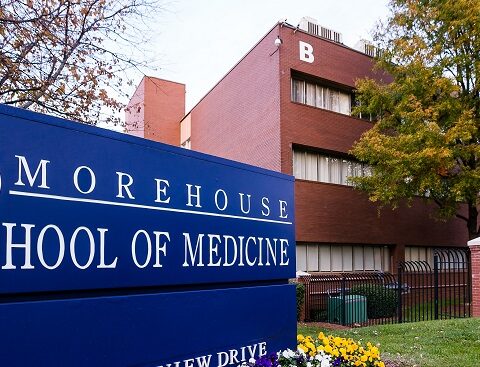Courtesy of Morehouse School of Medicine
The Center for Maternal Health Equity at Morehouse School of Medicine (MSM) will receive nearly $2.3 million over five years in funding from the Health Resources and Services Administration (HRSA), a bureau of the US Department of Health and Human Services (HHS). The grant is among nearly $90 million in new awards to support the White House Blueprint for Addressing the Maternal Health Crisis, a whole-of-government strategy to combat maternal mortality and improve maternal and infant health, particularly in underserved communities. Morehouse School of Medicine’s grant is among those awarded to Historically Black Colleges and Universities (HBCUs) and other minority-serving institutions (MSIs).
In recent decades, the United States’ maternal mortality rate has been among the highest of any developed nation. Disparities in mortality are stark — Black women are more than three times as likely as white women to die from pregnancy-related causes. The Biden-Harris Administration is committed to reversing these trends and making the US the best country in the world to have a baby.
“Georgia has one of the worst rates of maternal mortality and morbidity in the US, especially for people of color. In addition, a third of the counties in Georgia are considered maternity care deserts due to a lack of healthcare providers,” said Center for Maternal Health Equity Executive Director Natalie D. Hernandez-Green, PhD, MPH. “This new funding from the federal government will allow the Center to expand on our vital work to eradicate this disparity and dramatically improve health outcomes for pregnant and postpartum people in urban and rural areas throughout the state — a community-based approach that serves as a model to other communities nationwide.”
“At the Health Resources and Services Administration, we are laser-focused on reversing this crisis by expanding access to maternal care, growing the maternal care workforce, supporting moms experiencing maternal depression, and addressing the important social supports that are vital to safe pregnancies,” said HRSA Administrator Carole Johnson. “We know it will take a sustained approach to reduce and eliminate maternal health disparities and we are committed to this work.”
The new HRSA funding takes action on each of the five key goals laid out in the White House Blueprint for Addressing the Maternal Health Crisis.
WHITE HOUSE BLUEPRINT GOAL #1: Increase Access to and Coverage of Comprehensive High-Quality Maternal Health Services, Including Behavioral Health Services
HRSA ACTION ON GOAL #1:
- Expand access to maternal health care: HRSA is investing more than $24 million across 20 states to establish maternal health task forces with a focus on innovation and implementing strategies to improve maternal health service delivery, such as sending mobile health units to areas with fewer maternal health providers and ensuring more hospitals have equipment and safety protocols in place to save lives during delivery.
- Expanding screening and treatment for maternal depression and other mental health and substance use disorders: HRSA is investing nearly $9 million to support 12 states in training OB/GYNs, midwives and other maternal health providers in treating mental health and substance use disorders. This includes equipping maternal health providers with real-time teleconsultation support, linking them with psychiatrists and other mental health providers to better meet their patients’ behavioral health needs.
- Support maternal health in rural areas: HRSA is investing nearly $2 million in organizations in two highly rural states (Mississippi and New Hampshire) to develop strategies to meet their communities’ maternal and obstetric needs and implement evidence-based, sustainable delivery models in rural hospitals and communities.
WHITE HOUSE BLUEPRINT GOAL #2: Ensure Those Giving Birth Are Heard and Are Decisionmakers in Accountable Systems of Care
HRSA ACTION ON GOAL #2:
- Support parents in communities with the highest rates of maternal deaths: HRSA is investing $11 million to fund 10 new programs through our Healthy Start Initiative to provide direct services to pregnant and postpartum mothers – services such as care coordination, doula services and parent education classes – as well as to support community-wide efforts to address nonmedical factors that impact health outcomes, such as housing and nutrition. These resources will be patient-centered and accountable.
- Build birthing facilities’ capacity to reduce maternal death and severe illness: HRSA is investing more than $5.5 million to provide support to 28 states and jurisdictions to implement “patient safety bundles” in birthing facilities, through the HRSA-funded Alliance for Innovation on Maternal Health (AIM) program. Maternal patient safety bundles are patient-centered strategies to improve health system accountability using sets of practices that improve the quality of care provided during delivery and in the postpartum period, addressing critical issues such as obstetric hemorrhage, severe hypertension, and care for those with substance use disorder.
WHITE HOUSE BLUEPRINT GOAL #3: Advance Data Collection, Standardization, Transparency, Research, and Analysis
HRSA ACTION ON GOAL #3:
- Invest in maternal health research: HRSA is investing nearly $10 million to establish a new research network that will support minority serving institutions of higher learning to study the disparities in maternal health outcomes and identify effective methods and strategies for addressing them.
WHITE HOUSE BLUEPRINT GOAL #4: Expand and Diversify the Perinatal Workforce
HRSA ACTION ON GOAL #4:
- Grow the maternity nursing workforce: HRSA is investing $8 million to train and deploy more nurse midwives by supporting nurse midwifery programs at 10 universities to grow the maternal health nursing workforce and expand access to care.
- Strengthen the home visiting workforce: HRSA is investing $4.5 million to establish the Institute for Home Visiting Workforce Development and Jackie Walorski Center for Evidence-Based Case Management to help state Maternal, Infant, and Early Childhood Home Visiting programs recruit, train, and retain a diverse home visiting workforce ready to meet the needs of families across the country.
WHITE HOUSE BLUEPRINT GOAL #5: Strengthen Economic and Social Supports for People Before, During, and After Pregnancy
TODAY’S HRSA ACTION ON GOAL #5:
- Increasing access to integrated maternal health services: HRSA is investing more than $8 million in five states to improve pregnancy and postpartum care by expanding access to basic social and health services and fostering linkages among health care providers, social service organizations, state Medicaid programs, and health departments.
- Support mothers and their families with Medicaid eligibility redeterminations: HRSA is investing nearly $6 million to help ensure that new mothers and their families are supported during the Medicaid redetermination process associated with the end of the COVID-19 Public Health Emergency. Funding will enable local organizations to help families most in need navigate their states’ Medicaid redetermination process.





